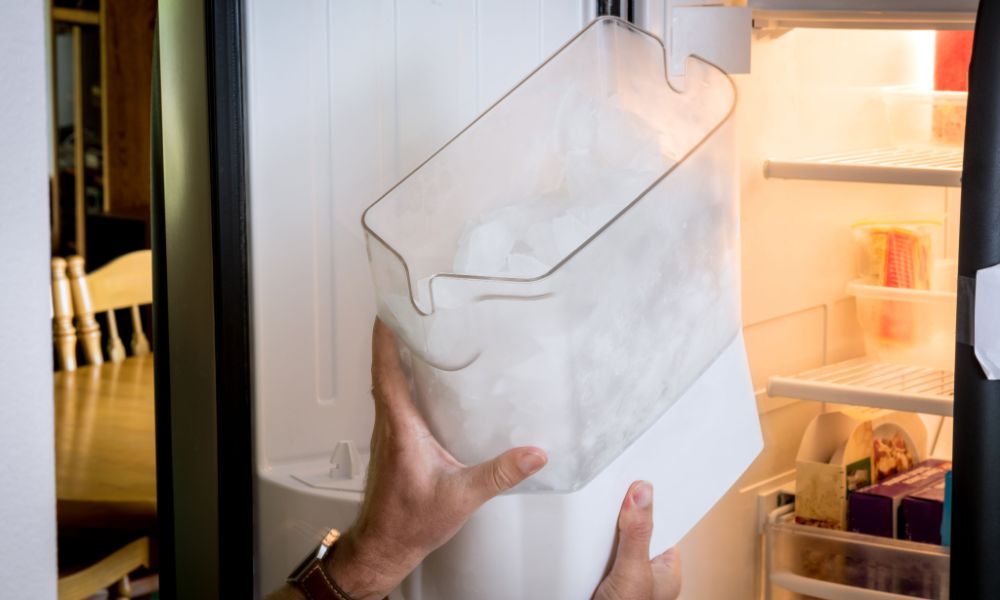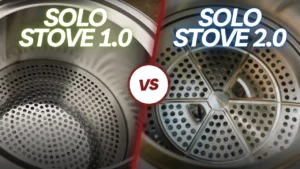Most modern Samsung refrigerators come equipped with an ice maker complete with a storage basket. As the ice maker runs, it completely fills up the storage basket with cubes, allowing you to dispense ice whenever you want it.
It'll also stop producing ice once the basket it full and won't dispense ice again until the basket is emptied. But how exactly does the Samsung ice maker know when to start and stop making ice?
Your Samsung ice maker knows when to stop making ice because of a lever-arm sensor or an optical level sensor. One of these sensor types detects when the ice reaches the top of your maker’s bin and shuts the ice maker off. Both sensors reliably manage ice levels, but they do the job in very different ways.
Ice makers are impressive machines that rely on precise sensors and mechanisms. Learn how to tell which ice level sensor your maker has, as well as potential problems to watch for that can stop your ice maker.
Samsung Ice Makers Use Lever Arm or Optical Sensors
Samsung ice makers depend on one of two different types of sensors, a lever arm or an optical sensor. Both technologies works reliably, but the model of the refrigerator you have in your home will determine which of the two technologies you have.
If your ice maker isn’t shutting off when full, chances are good that your ice level sensor isn’t functioning properly.
Without a functional level sensor, your ice maker has no way of knowing what the current level of ice is in your ice maker basket and may continue to make ice and overflow the basket or may shut off completely and not make any ice at all.
How to Determine Which Ice Level Sensor Your Refrigerator Has
It only takes a moment to determine which ice level sensor your refrigerator is equipped with.
Begin by opening the door to your freezer, where your ice maker is located.
Look at the ice maker just above where the ice basket is positioned. If the basket has a metal lever arm that hangs down from the maker, your machine is equipped with an arm-style sensor.

If you don’t see a metal lever arm, you likely have an optical sensor.
Remove the ice maker basket and look for a pair of special electronic sensors mounted on either side of the ice maker basket. These components work together to sense when the ice level is at the top of your ice basket.
The optical sensor often has a glowing red light, and many feature an on-and-off switch as well.
In the video below you can see what the sensor looks like in one Samsung fridge.
How Samsung Lever Arm Ice Level Sensors Work
Any ice maker equipped with a lever arm sensor relies on a simple mechanism to determine when the ice level is at its maximum.
The ice maker has an external metal arm. As ice is dispensed into the basket this metal arm raises up. When the basket is empty this metal arm will return to its starting position completing the electric circuit and letting the ice maker know the basket is not full.
Water will flow into the ice maker starting the cycle again.
If the basket is too full the the metal arm will not snap back into its lowered position and the ice maker will know it's full.
As ice is removed from the basket, the lever arm will move back down completing the electric circuit and beginning the ice making cycle.
This arm moves up and down every time ice is dispensed so with each cycle it is checking whether or not the bin is full before allowing water to flow in and starting the ice making cycle again.
To manually switch off the ice maker you can raising this bar and sometimes this bar gets stuck in the up position when it shouldn't be and this can cause your Samsung ice maker to stop making ice.
How Samsung Optical Ice Level Sensors Function
Each Samsung ice maker optical sensor system performs the same function as a lever arm sensor. The only difference is that instead of a mechanical arm, the sensor relies on a light transmitter and receiver.
During use, the light transmitter sends an optical signal across the ice basket to the receiver on the other side of the freezer. As long as the ice basket isn't full this optical signal will travel across to the sensor unimpeded.
However, when the ice bin is full of ice, the optical beam no longer reaches the receiver. When the receiver doesn’t see the beam, the ice maker is deactivated, and ice production stops.
As ice is dispensed from the bin, the level of ice goes down and eventually allows the optical beam to reach the receiver once again. This turns the ice maker back on and increases the level of ice again.
The same this happens when the freezer door is opened. A flap covers the sensor so the ice maker knows to stop production. However, once the door is closed the flap is returned to its correct position and the sensor can detect the optical beam again.
Level Sensors Control Power to the Ice Maker
Both of the ice level sensors work by controlling when the ice maker is on and when it’s off. By giving the sensors direct control of the ice maker cycle, the sensors can cause the ice level to go up or down depending on your current needs.
The sensors control ice levels effectively when they’re functioning properly.
There are instances where faulty ice sensors lead to overflowing ice cubes, or empty ice bins, depending on the sensor issue.
How a Malfunctioned Ice Level Sensor Impacts Ice Levels
The most common issue that occurs when an ice level sensor stops functioning is an empty ice bin.
Most often, a faulty level sensor keeps the ice maker deactivated, preventing it from creating any additional ice. This problem can be caused by a failing sensor, as well as an obstructed sensor.
Often built-up ice clinging to your ice bin can cause your sensor to malfunction. Learn how to melt ice effectively in your freezer to clear up this issue.
There are instances where a faulty sensor causes the ice maker to continue producing ice even after the bin is full. This issue can lead to an overflowing freezer, a jammed ice maker, and other problems. However, this problem is more rare.
If you notice your ice maker is constantly running, start by ensuring your ice bin is mounted properly and that ice isn’t falling down into your freezer below. If the bin is secured, you may have an issue with your level sensor itself.
If your ice maker stops functioning, consider these tips to help you utilize an ice cube tray effectively until your maker is repaired.
How Do Samsung Ice Makers Work?
As you become used to your Samsung ice maker, you’ll likely stop thinking about how the machine is creating ice and just enjoy using it.
There’s a lot of technology behind a modern ice maker, though. So how does a Samsung ice maker work? How does it create the perfect ice cubes that so many people take for granted today?
Samsung ice makers pump water into a chilled ice tray gradually. As the water is added to the tray, it freezes into full-sized cubes. A thermostat detects when the ice cubes are frozen and heating element is turned on for a short period of time to detach the ice. A set of pins will sweep through the tray removing the ice and the process will start again.
Below you can see the internal workings of an ice maker as it releases ice and refills the ice tray.
Now that you understand how your Samsung ice maker works, you can begin considering what potential problems your machine is suffering from if the ice maker stops working.
Will a Samsung Ice Maker Work Without a Water Filter?
As your Samsung refrigerator filter is used, it slowly becomes worn and eventually clogged. An old filter can stop the flow of water and ice to your ice maker. When this happens, you may wonder if you can just remove the filter and run your ice maker without it?
In many Samsung ice makers, it’s possible to run them without a filter, but the ice won’t be as clear or as clean. It’s important to note that some Samsung ice maker models require a special bypass valve to operate the machine without a water filter installed.
If your Samsung water filter becomes clogged or stops functioning, you can try running the machine without a filter to see if it will work. If you face issues with the filter, you’ll know that you likely need to add a bypass part to stop using a filter.
Summary
Whether your Samsung ice maker relies on a lever arm ice level sensor or an optical sensor, the machine should stop ice production precisely when the ice bin is full. If your ice level isn’t being maintained properly, you may have a faulty sensor in need of replacement.




